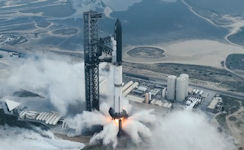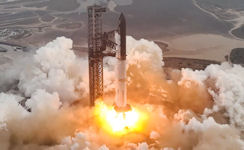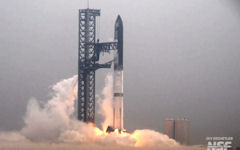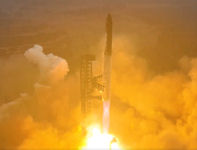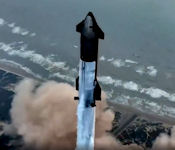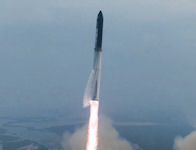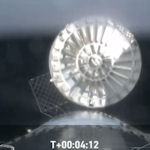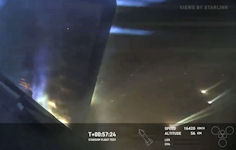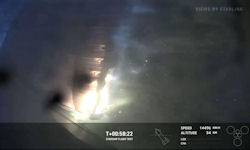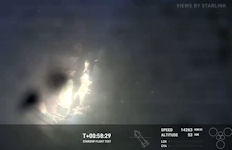SpaceX Starship Flight 4
SpaceX's Starship spacecraft and Super Heavy rocket , collectively referred to as Starship, represent a fully reusable transportation system designed to carry both crew and cargo to Earth orbit, the Moon, Mars and beyond. The fourth flight test of Starship - Booster 11 and Ship 29 - launched 06 June 2024 from Starbase in Texas. The 120-minute test window opened at 7:00 a.m. CT. A live webcast of the flight test began about 30 minutes before liftoff. The launch window opened as early as 7 a.m. CT. The rocket, lifted off at about 7:50 a.m. local time (1250 GMT).
The company's three previous attempts resulted in destruction of the rockets before the flights were completed. Starship’s third flight test made tremendous strides towards a future of rapidly reliable reusable rockets. The test completed several exciting firsts, including the first Starship reentry from space, the first ever opening and closing of Starship’s payload door in space, and a successful propellant transfer demonstration. This last test provided valuable data for eventual ship-to-ship propellant transfers that will enable missions like returning astronauts to the Moon under NASA’s Artemis program.
The fourth flight test turned the focus from achieving orbit to demonstrating the ability to return and reuse Starship and Super Heavy. The primary objectives will be executing a landing burn and soft splashdown in the Gulf of Mexico with the Super Heavy booster, and achieving a controlled entry of Starship. To accomplish this, several software and hardware upgrades have been made to increase overall reliability and address lessons learned from Flight 3. The SpaceX team will also implement operational changes, including the jettison of the Super Heavy’s hot-stage following boostback to reduce booster mass for the final phase of flight.
Flight 4 flew a similar trajectory as the previous flight test, with Starship targeted to splashdown in the Indian Ocean. This flight path did not require a deorbit burn for reentry, maximizing public safety while still providing the opportunity to meet the primary objective of a controlled Starship reentry. The fourth flight of Starship aimed to bring SpaceX closer to the rapidly reusable future on the horizon. SpaceX is continuing to rapidly develop Starship, putting flight hardware in a flight environment to learn as quickly as possible to build a fully reusable transportation system designed to carry crew and cargo to Earth orbit, the Moon, Mars and beyond.
Minutes after liftoff, SpaceX confirmed Starship's Raptor engines had ignited during hot-staging separation. The first-stage booster, known as Super Heavy, executed the flip maneuver and boostback burn. Super Heavy has splashed down in the Gulf of Mexico. Starship coasted in space, and re-entered the Earth's atmosphere. About 1 hour and 5 minutes after launch, SpaceX confirmed Starship's splashdown in the Indian Ocean.
- The Super Heavy booster lifted off successfully and completed a full-duration ascent burn.
- Starship executed another successful hot-stage separation, powering down all but three of Super Heavy’s Raptor engines and successfully igniting the six second stage Raptor engines before separating the vehicles.
- Following separation, the Super Heavy booster successfully completed its flip maneuver, boostback burn to send it towards the splashdown zone, and jettison of the hot-stage adapter.
- The booster’s flight ended with a landing burn and soft splashdown in the Gulf of Mexico seven minutes and 24 seconds into the flight.
- Starship's six second stage Raptor engines successfully powered the vehicle to space and placed it on the planned trajectory for coast.
- Starship made a controlled reentry, successfully making it through the phases of peak heating and max aerodynamic pressure and demonstrating the ability to control the vehicle using its flaps while descending through the atmosphere at hypersonic speeds.
- Starlink on Starship once again enabled real-time telemetry and live high-definition video throughout every phase of entry, with external cameras providing views all the way to the flight’s conclusion.
- Flight 4 ended with Starship igniting its three center Raptor engines and executing the first flip maneuver and landing burn since our suborbital campaign, followed by a soft splashdown of the ship in the Indian Ocean one hour and six minutes after launch.
The fourth flight of Starship made major strides to bring us closer to a rapidly reusable future. Its accomplishments will provide data to drive improvements as we continue rapidly developing Starship into a fully reusable transportation system designed to carry crew and cargo to Earth orbit, the Moon, Mars and beyond. Flight 4 flew similar trajectory as the previous flight test, according to SpaceX. The company's three previous attempts resulted in destruction of the rockets before the flights were completed. SpaceX founder and CEO Elon Musk congratulated SpaceX team on the achievement. "Despite loss of many tiles and a damaged flap, Starship made it all the way to a soft landing in the ocean!" Musk said on X.
|
NEWSLETTER
|
| Join the GlobalSecurity.org mailing list |
|
|
|

